Black Lady:
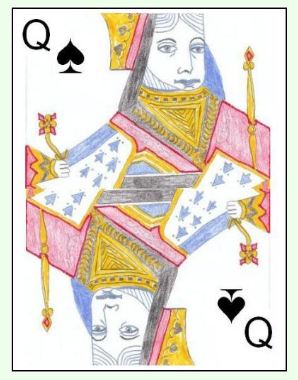
In this often played version of Hearts, the Queen of Spades is played as an additional penalty card when won in a trick. The player, who at the end of the hand finds the Queen of Spades in their won tricks scores 13 penalty points. In this version the player to lead to the first trick may not lead spades or hearts (unless he has only spades and/or hearts in his hand) to the first trick. In order to shoot the moon in this version, the player must win all the hearts AND the Queen of Spades (which allows the player to subtract 26 points from their score or add 26 penalty points to each opponents score). In all other aspects Black Lady is played identically to standard Hearts as described above.
Greek Hearts:
Greek Hearts is played identically to Black Lady with one exception in the scoring for a player who manages to shoot the moon. In this variant, if a player manages to shoot the moon (take every Heart as well as the Queen of Spades) he is entitled to subtract from his score 26 points for each other player in the game. In addition, each opponent must add 26 points to his own score. In all other respects, Greek Hearts is played identically to Black lady.
First Lead:
When playing hearts with four players, it is often played that the player who has the two of clubs plays first, playing this card. The player to that players immediate left plays the next card to the trick and so on as in regular hearts.
No Break required:
In this optional rule, the restriction on waiting until a heart has first been discarded to a trick before a heart can be led is removed.
Jack of Diamonds:
In this version of Hearts, often called Omnibus Hearts, the player who wins the Jack of Diamonds in a trick may subtract 10 "penalty" points from their score at the end of the hand. Shooting the moon and obtaining the Jack of Diamonds is cumulative, so the player able to shoot the moon and obtain the Jack of Diamonds may subtract 36 total points from their hand.
Spot Hearts:
This version is played similarly to Black Lady, with the following exception. Instead of each heart won in a trick being worth 1 penalty point, the hearts are valued as per the rank of the card. Thus, an Ace would be one penalty point, Deuce 2 points, three counts as three, etc. In this way, the Jack is worth 11 points, Queen 12 and King 13. If a player manages to shoot the moon (every heart and the queen of spades) they instantly win the game.
Rickety Kate:
Rickety Kate is an Australian version of Black Lady. It is played
identically to Black Lady with the following differences:
- The player who has the three of Clubs always leads to the first trick (leading with that card).
- Shooting the moon is generally not an option in Rickety Kate.
- The number of points scored for each captured card is as follows:
| Card | Score if Captured in a Trick |
|---|
| Rickety Kate (Queen of Spades) | 13 |
| Ace of Hearts | 4 |
| King of Hearts | 3 |
| Queen of Hearts | 2 |
| Jack of Hearts | 5 |
| 2, 3, 4, 5, 6, 7, 8, 9, 10 of Hearts | 1 Point Each |
| All other cards | 0 |
- At such time, at the end of a hand any player exceeds 100 points, the game ends. The player who currently has the lowest total score is declared the winner.
- If a player's score is exactly 100 points after the points are totaled at the end of a hand, that player may immediately subtract 50 points from his current score.
In all other aspects, Rickety Kate is played identically to Black Lady.
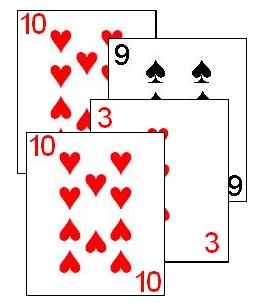 Cancellation Hearts
Cancellation Hearts:
This is a fast-paced variation of the standard game of Hearts for a larger number of players. Cancellation Hearts is usually played by 6 to 11 players.
Two standard 52 card decks are shuffled together. All of the cards should be dealt out as far they can be dealt with each player getting the same number of cards. Any extra cards should be placed face down in the center of the table to be taken by the winner of the first trick. The ranking of the cards is the same as in the standard game and the game is played identically to Black Lady with a few exceptions:
If two players play a card of the exact same suit and rank, both of those cards are considered to cancel each other out and neither can win the trick (no matter their rank or suit). Thus, when determining the winner of that particular trick, the matching cards take no part in this determination. If two exact pairs are played to the same trick, the trick is said to be dead and set aside. The player winning the next trick takes these cards in addition to those from the trick won. If this is the last trick of the hand, these cards are out of play and no one takes these cards for this particular hand. In order to shoot the moon in this game, they must take EVERY heart as well as both spade Queens. Cancellation Hearts is usually played to 150 points.
Domino Hearts:
Domino Hearts is a fun variation combining features of Hearts and Rummy. The game is played identically to the standard game with the following differences:
- Each player is dealt an initial hand consisting of six cards. The remainder of the deck is placed in the center of the table face down as a stock pile.
- If a player on his turn has no cards of the suit led to the trick he must draw a card from the stock. If the card drawn is also not of the led suit, the player must draw another card and continue to draw until he draws a card on which he can play to the trick.
- Once the stock pile has been depleted a player unable to follow the suit led to the trick can play any legal card from his hand. Not being of the original led suit of the trick, this card can thus not win the trick.
- When a player runs out of cards, he is out for the rest of the hand. He is still responsible for all the negative point scoring cards he may have won in tricks, however.
- As in the standard game the winner of a trick leads to the next trick. However, if the winner of a trick won the trick with the last card in his hand, the lead passes to the next player to his left who still has cards in their hand.
- If all but one player run out of cards in the hand, the extra cards in this players hand are added to his cards as if they were "won" tricks for scoring.
The winner of the game is the player with the lowest score when any player reaches or exceeds 31 points.
Auction Hearts:
Auction Hearts is a fun Hearts variant in which players bid to name the penalty card suit. To begin, each player in a game of Auction Hearts is distributed an equal number of chips or other similar tokens (i.e. 50).
Auction Hearts is for 3 to 7 players and uses one standard 52 card deck with the same ranking as used in standard Hearts. The shuffle and deal are similar to standard Hearts, however no card passing occurs.
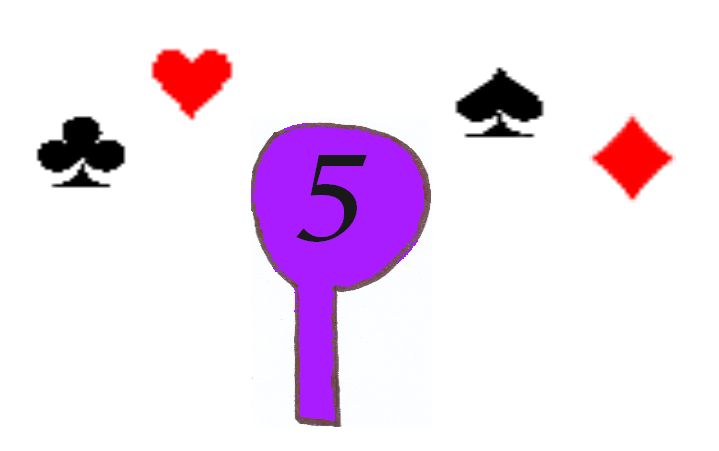
After the deal, each player then examines his hand and one round of bidding follows. This bidding begins with the player to the immediate left of the dealer and commences in a clockwise rotation. Each player has one opportunity to bid some number of chips in exchange for the privilege of naming the penalty suit for the hand. When bidding a player only names a number but does not name the suit he will name if he is the high bidder.
Each successive bidder must either pass or bid a higher bid than that of any other player. Obviously, a player may never bid a number of chips higher than the number of chips he has. After each player has had one opportunity to make a bid, the high bidder then places the number of chips he bid in the center of the table and names the suit which will be the penalty suit. The high bidder also makes the opening lead to the first trick. If all players pass, the cards are shuffled together and the deal passes to the next player in turn.
The play of the hand is similar to the standard game of Hearts, with players attempting to avoid winning any cards of the suit named by the high bidder during the hand. At the end of the hand, each card taken by a player of the penalty suit named must pay a penalty of one chip per card to the growing pile of chips in the center of the table. If any player manages to take no cards of the penalty suit, they win the entire pile of chips after everyone has put in their penalty chips. If two players manage to take no cards of the forbidden suit, they divide the pile of chips between them. If there is an odd chip, it remains in the center of the table to start the pile of chips for the next hand.
However, every player takes at least one card of the forbidden suit or more than two players manage to take no cards of the penalty suit, no one wins the hand and the growing pile remains for the next hand. If one player manages to take every card of the penalty suit, no one wins either, and furthermore this player does not have to make any penalty payments on the hand. In this way, if no player wins the pile, the deal rotates to the next player, but the highest bidder on that previous hand automatically is given the privilege of again naming the penalty suit (without having to bid or make any chip payment for the privilege).
At the end of the game, the player retaining the largest number of chips is declared the winner. In the event of a tie, an additional hand should be played in order to attempt to break the tie.
Polignac:
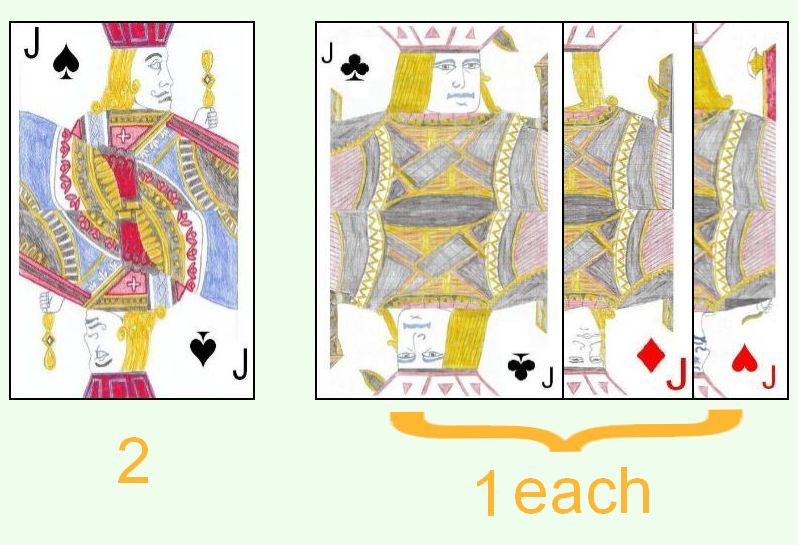
This is another game which uses the Hearts concept of trying avoid certain penalty cards during play. Also commonly known as Four Jacks, Four Knaves and Quatre Valets, this game uses a stripped down deck with the number of cards depending on the number of players in the game. The most commonly played version of Polignac is for four players using a 32 card deck which consists of one card in each suit in the following denominations (from high to low); Ace, King, Queen, Jack, 10, 9, 8, 7. Shuffling, determining the first dealer and seating positions is done identically to the standard game of Hearts. After the shuffle and cut, the dealer distributes the cards in a clockwise rotation one card at a time until each player has 8 cards. The player to the immediate left of the dealer leads any card of his choice to the first trick.
Similar to standard Hearts, the object in this game is to avoid capturing in tricks any of the Jacks which cost the player winning them a certain number of points. Each Jack won in tricks by a player costs him one point except the Jack of Spades (♠), called the Polignac, which penalizes the winner of that card 2 points. However, a player who believes that he can win all four Jacks, may declare, before the first lead, Capot. This declaration is the intention of a player to win all four Jacks. If he is able to do so, he subtracts 10 points from his score and each other player adds 10 to theirs. However, if he is unable to win all four Jacks he instead gains 10 points with each other player subtracting 10 from their own score. The play of the hand proceeds identically to standard Hearts, with each player in turn playing one card to the trick. A player must play a card of the suit led if they have one. If they do not have such a card, they may play any card from their hand. The highest card of the suit led wins the trick and the winner of the trick leads the first card to the next trick.
In addition to the penalty points for winning the Jacks, there also are additional penalty points accrued by winning the first and last trick of the hand, with each earning the player one penalty point.
When any player reaches or exceeds 20 points over the course of several hands, the game is over, with the winner being the player who has the least total points.
This game can also be played by five or six players, with the removal of the Seven of Spades (♠) and the Seven of Clubs (♣) with each player receiving fewer cards during the hand. When playing with five players, each would receive 6 cards and when playing with six each would receive 5.
Slobberhannes:
Slobberhannes is another game with the object being to avoid winning specific tricks or cards. Slobberhannes uses a modified standard deck, with all the sixes and lower removed. The rank of the remaining cards are as follows (from high to low): Ace, King, Queen, Jack, 10, 9, 8, 7. Selection of first dealer and seating positions is the same as in standard Hearts. It is generally best when played by four players, but can also be played by more (see below).
Once the dealer is determined, the dealer deals out the entire deck, with each player receiving eight cards. The player to the dealer's immediate left plays the first card to the first trick. Each player must play a card of the suit led if they have one. If he has no card of the suit led, they may play any card to the trick. The highest card of the suit led to each trick wins the trick. The winner of each trick leads the first card to the next trick.
In this game, the players attempt to avoid winning specific tricks. Winning the first trick of the hand earns the player one penalty point as does winning the last trick of the hand. In addition, winning the Queen of Clubs (♣) earns the player one penalty point. If the same player wins the first trick, last trick and Queen of Clubs, they earn four penalty points instead of just three.
When any play earns 10 points the game ends. The player with the fewest points is declared the winner.
Similar to Polignac, Slobberhannes can also be played by five or six players by removing the Seven of Spades (♠) and the Seven of Clubs (♣). In the case of 5 players each participant would receive 6 cards and for 6 players each would receive 5 cards.
Knaves:
Knaves is a fun and exciting card game which combines positive points for winning tricks with negative points for winning the Jacks. The game is designed to be played by 3 to 5 players using a standard 52 card deck. The ranking of the cards are as follows, from high to low; Ace, King, Queen, Jack, 10, 9, 8, 7, 6, 5, 4, 3, 2.
The determination of first dealer and seating positions can be done as in standard Hearts or any of it's variants. Once this is determined, the dealer deals the cards in a clockwise direction until each player has the necessary number dependent on the number of players.
- Three Players
: Each player receives 17 cards and the last card in the deck is turned over in the center of the table to determine the trump suit for the hand.
- Four Players
: Each player receives 13 cards. The dealer's last card is exposed in the center of the table to determine the trump suit for the hand. Before he plays to the first trick, the dealer should take this exposed card into his hand.
- Five Players
: Each player receives 10 cards. The next card is turned up in the center of the table to determine the trump suit. The last card is set aside, face down, and it and the exposed trump card go to the winner of the last trick in the hand.
After the dealing procedures have been completed, the player to the dealer's immediate left plays the first card to the first trick. Each other player, in a clockwise direction then plays one card to the trick. A player must play a card of the suit of the first card led to the suit if they have one. If not, the player may play any card in his hand, including one from the trump suit. The highest trump card played to the trick wins it. If no player played a card of the trump suit to the trick, it is won by the highest card of the suit first led to the trick. The winner of each trick leads the first card to the next trick.
As in Polignac, there are penalties for winning specific cards in tricks. However, like Whist, points can be earned for winning tricks.
The following chart shows a summary of the points possible during a hand of Knaves:
| Description | Points Earned |
|---|
| Each trick Won | +1 |
| Winning Jack of Hearts (♥) | -4 |
| Winning Jack of Diamonds (♦) | -3 |
| Winning Jack of Clubs (♣) | -2 |
| Winning Jack of Spades (♠) | -1 |
The first player to reach or exceed + 20 points over the course of several hands is declared the winner.
Two Player Hearts:
Since standard Hearts and most of it's variants are designed for three or more players, a version for two players has also been designed. This version uses the standard 52 card deck and the same card ranking as in the base game.
After determining the first dealer (using the same method as in regular Hearts), the dealer distributes 13 cards to each player. The remaining cards are set face down in a pile in the center of the table as the stock. The turn to deal alternates between the two players.
The dealer's opponent leads the first card to the first trick. The dealer then plays a card of his own to the trick. He must play a card of the same suit as that led to the trick if he has one. If not, he may play any card to the trick. The highest card of the suit led wins the trick. The winner of the trick takes the top card of the stock and his opponent takes the next card of the stock. The winner of each trick leads to the next. When the stock is exhausted the players then play out the last cards in their hand as normal.
This game is usually scored similar to standard Hearts, with each heart taken by a player assessing that player one penalty point. Once a player reaches 100 or more penalty points at the end of a hand, his opponent is declared the winner.
Hooligan Hearts:
Hooligan Hearts is played identically to Black Lady, with the following modifications to the rules:
The Seven of Clubs (♣) earns the player who wins it in a trick seven penalty points.
The player who captures the 10 of Diamonds (♦) in a trick is entitled to subtract 10 points from his current total.
|
|
|
A player who manages to capture all the Hearts, Queen of Spades, Seven of Clubs and the 10 of Diamonds during a hand is entitled to subtract 43 points from his current score. If a player is able to capture all the Hearts, Queen of Spades and Seven of Clubs but not the 10 of Diamonds, that player may subtract 33 points from their score.
Gong Zhu:
Gong Zhu (Chase the Pig) is a Chinese game played somewhat similar to Hearts. As the game does have some significant differences from standard Hearts, please see our rules page for
Gong Zhu for the detailed instructions for playing.
Pink Lady:
Pink Lady is another interesting variant of Hearts featuring additional penalty cards. This variant is played identically to Black Lady, however, with a few important differences: The player who captures the Queen of Hearts (called the Pink Lady) must add 13 points to his total score. Capturing the ten of Diamonds in a trick allows the capturing player to subtract 10 points from his current score. A player who manages to take all the Hearts, the Queen of Spades and the Jack of Diamonds during a hand is entitled to subtract 38 points from his own score.
Heartsette:
Heartsette is a fun variant of Hearts which can be played by three to eight players. The number of cards initially dealt to each player is dependent on the number of participants, as shown in the following chart:
| Number of Players | Cards Dealt Per Player | Adjustments to Deck |
|---|
| 3 | 16 | Two of Clubs removed from Deck |
| 4 | 12 | Two of Clubs removed from Deck |
| 5 | 10 | - |
| 6 | 8 | - |
As will be noticed from the chart, with 3 or 4 players, the two of Clubs should be removed from the deck, resulting in a 51 card deck.
After the cards have been distributed by the dealer, the remaining cards in the deck are placed face down in the center of the table as a widow hand. The winner of the first trick must add all the cards from the widow hands into his cards won. Any points found in this hand are earned by the player capturing the first trick. The player capturing the first trick may view the cards in the widow hand before adding them face down to his captured cards.
In all other respects this game is played identically to standard Hearts.
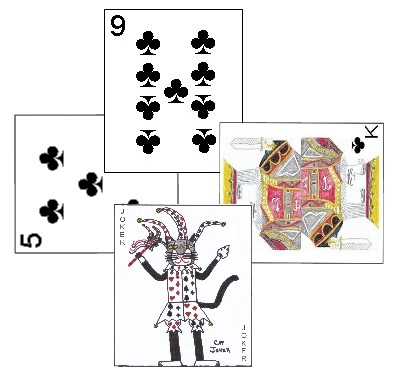 Joker Hearts
Joker Hearts:
Joker Hearts is a variant of Hearts featuring the use of one Joker. In the usual variant, the two of Hearts is replaced with one Joker, thus retaining a 52 card deck. This Joker is a special card which wins any trick it is played to. However, if a trick also contains the Jack of Hearts, Queen of Hearts, King of Hearts or Ace of Hearts that card will beat the Joker. The player capturing the Joker must add 5 points to his current score for capturing it. In all other respects Joker Hearts is played identically to standard Hearts.
An alternative form of Joker Hearts is to add the Joker without removing any of the other cards (such as the two of Hearts). In this variant, after each player receives his hand, the last card of the deck is placed face down in the center of the table as a widow. The player who wins the first trick must add this card to his cards won during the hand. Other than this one difference, this variant is played as in basic Joker Hearts described directly above.
Reversis:
Reversis is an ancient game, which is thought may be the original ancestor of the current game of Hearts. It's first mention can be found in France in the year 1601 (using the slightly different original name Reversin), however it is thought to be a game of Spanish origin. Although similar in spelling to Reversi (a strategy board game for two players), this game should not be confused with that game, which is a completely different game and unrelated to this one.
Reversis is designed to be played by four players using a 48 card deck. This deck can be formed by removing the four tens from a standard 52 card pack. The ranking of the cards in this deck are as follows (from high to low); Ace, King, Queen, Jack, 9, 8, 7, 6, 5, 4, 3, 2. Scoring is usually done using special counters or chips (called fish). At the start of the game, each player is provided an equal number of these chips, in three denominations; 36 each worth 1 unit, 24 worth 6 units each, and 6 worth 8 units each.
Selection of seating positions and first dealer can be done using a variety of methods, with drawing for low card a common method. At the start of the game, each player places
a total of chips equal to five units into a pile in the center of the pile. For each hand, the current dealer places an additional 5 units into this pile. The dealer then distributes the cards in a counter-clockwise direction around the table starting with the player to his right. In so doing, he first deals each player a packet of four cards, then a packet of three, and then another packet of four, all face-down. All players should then have 10 cards. After this, he deals one more face-down card to himself, and then one face down card in the front of each player. The dealer then picks up all 11 cards dealt to himself and then discards any one card of his choice from his 11 card hand, face-down to the center of the pile to begin
the talon. The other players then also take their 10 card hands (leaving the 11th face down card in front of themselves) and examine them. After doing so, these players than may elect to discard any card of choice from their own hand, replacing it by picking up the face-down card in
front of themselves. They place the discarded card, face-down card in the center of the table to form a
portion of the talon. If the player elects not to discard a card from his hand, he may look at the face-down card dealt in front of himself and then must place it face-down in the center of the table as part of the talon.
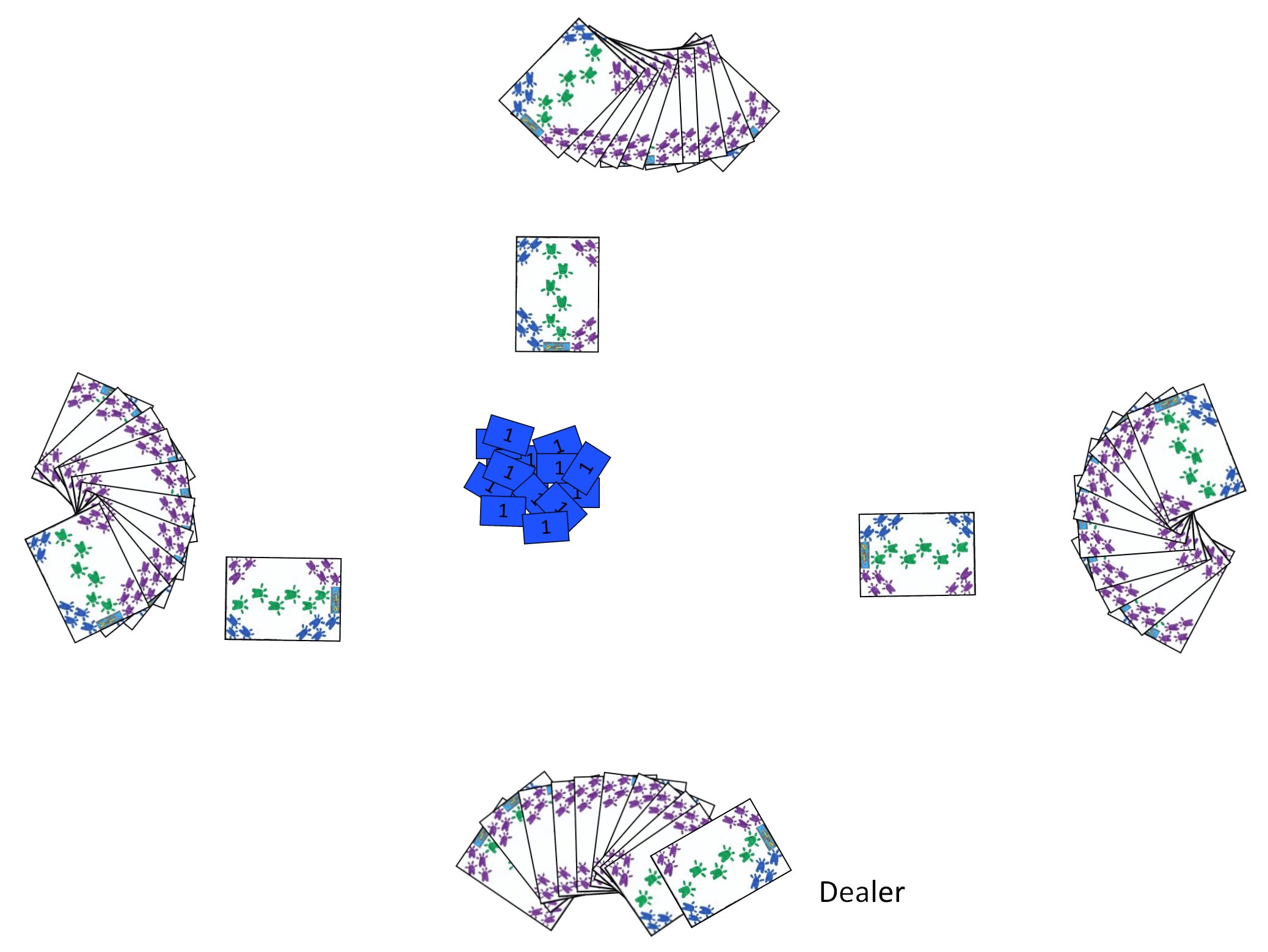
After these procedures have been completed, each player should then have 10 cards and there are four cards in the center of the table forming the talon. The player to the immediate right of the dealer begins by leading the first card to the first trick. He may lead any card of his choice from his hand. Each other player, in a counter-clockwise order must then play one card to the trick. If he has, in hand, one or more cards of the same suit as played to the trick, he must play one. If not, he may play a card of any suit to the trick. After all four players have played one card to the trick, trick is then won by the highest card played of the suit originally dealt to this trick. The winner of each trick leads the first card to the next trick.
During play, certain cards or events will require certain distributions of chips by the other players, as follows:
- If a player plays the Jack of Hearts (called Quinola and named after a 17th Century Spanish Admiral)
or any Ace to a trick in which a card of another suit was led,
the player of that card receives a number of chips from the winner of said trick; Quinola 5 chips, Ace of Diamonds 2 chips, any other Ace 1 chip.
- If a player plays an Ace to a trick in which the same suit was originally led by another
player, he must give the leader of that trick 2 Chips if the card is the Ace of diamonds, or 1 chip for any other Ace.
- If a player plays Quinola to a trick in which Hearts were originally led, the player who played Quinola must pay the leader 10 chips and all other players must give the leader 5 chips.
- If a player leads an Ace or Quinola to a trick, the winner of the entire hand may, at the and of the hand (but before the next hand begins) demand payment as follows; Quinola - 10 chips from the player of the card and 5 chips from the other players, Ace of Diamonds - 2 chips from the player who played the Ace, Any other Ace - 1 chip from the player who played the card.
Any payments to a player directly opposite at the table are paid double these amounts. During the last two tricks of the hand, these payments are also doubled. This doubling is cumulative, such that chips given to a player directly opposite on one of the last two tricks of the hand is
paid at quadruple the listed amount.
In addition, when Quinola is either led to a trick or played to a trick of the same suit led by another player, the player playing Quinola must also add chips to the center pile. If this is the first time that player has played Quinola in this fashion, he must place a number of chips from his own stock into the center pile to double the current number there. If this player has already doubled the pot in this manner, they must instead place the current amount in the main pile into a second, supplemental pile near the center of the table. The current pile is won by a player who manages to play the Quinola to a trick in which another suit was first led. When doing so the player who plays the card takes the entire current pile. When this occurs, the first supplemental pile (if any) becomes the new current pile. If there are currently no supplemental piles, a new pile is immediately made with the dealer placing 10 chips into a new pile and each other player adding 5 chips.
After all tricks have been played and won, additional scoring occurs. The following show the potential scoring opportunities and potential penalties based on tricks won:
- Reversis - A player managing to win all 11 tricks is said to have performed a Reversis. If a player manages to win the first nine tricks during the hand in succession, he must then attempt a Reversis. When this occurs, no further chip exchanges are required during the last two tricks of the hand. If the player who wins these first nine does manage to win all 11 tricks, he earns 16 chips from each other player and 32 chips from the player directly opposite him at the table. If Quinola was played during the first nine tricks, this player also wins the current center pile of chips. However, if the player does not manage to win the last two tricks, he must give 64 chips to the player who first won a trick during this hand against the player. If the player had played the Quinola during the first 9 tricks, the player must also double the current pile (creating a supplement center pile). If the first trick not won by the player who had won the first nine is won by the player of Quinola, the player playing that card must provide the usual payments to the player who led to that trick.
- Espagnolette - Managing to lose every trick during the hand is called an Espagnolette. If a player has in hand, after the optional discard, all four Aces or three Aces and Quinola, that player may announce Espagnolette. This declaration provides the player with specific benefits, but also certain requirements as well. A player who makes an Espagnolette declaration may revoke (play a card other than of the suit led even when having a card of the suit led) as often as he wants during the first nine tricks. However, for the last two tricks of the hand the player is required to follow suit. A player may also opt to play Espagnolette even without declaring it. However, if the player
revoked one or more times during the first nine tricks they are still obliged to the penalties if they win one or more tricks. If a player does manage to win no tricks during the hand (declared or not), he earns the reward for doing so. He first wins the normal chip awards for Party. He also wins any appropriate awards during play of the hand for forcing the play of the Quinola and the Aces. If two players tie for winning no tricks, the player first declaring Espagnolette during the hand is considered the winner (if any did declare this). However, if the player, after having made the declaration or having revoked to one or more of the first nine tricks, wins one or more tricks, he must give back all chips he received during this hand multiplied by two. You are also considered to be the winner of the most card points (regardless if another player actually won more) for purposes of calculating Party. If another player wins the hand with a Reversis, the player who was attempting Espagnolette must give the player who completed the Reversis 64 chips and all other players need give none to that winner. If the player who attempted Espagnolette however, wins one trick which causes a player to not get a Reversis, however, no chips exchanges are made at the end of this hand (the two cancelling each other out).
- In most cases, the player who captures the fewest card points wins a number of chips from the player who scores the most card points (called the Party). However, if either Reversis or Espagnolette is scored, this scoring does not occur. If two players tie for fewest card points, the player who won the least tricks is considered to be the winner. If this is also tied, whichever of these players is closed to the dealer in a clockwise direction (or first if they are the dealer) is considered to have won the fewest. Similarly, if more than one player are tied for most card points, the player amongst them who has won the most tricks is considered to have captured the most card points. If still tied, the player who is closest to the dealer in a counter-clockwise direction is considered to have won the most card points. The total number of cards points a player has won is determined by evaluating all the cards won by a player in tricks, as follows:
| Card | Card Point Value |
|---|
| Ace | 4 Each |
| King | 3 Each |
| Queen | 2 Each |
| Jack | 1 Each |
As in the required chip exchanges during the hand, any chips exchanged amongst players opposite each other at the table are paid at double.
After a set number of hands, the player who has the most chips is declared the winner of the game.
Conquimbert:
Conquimbert is another game which has sometimes
alternatively been postulated as the possible original ancestor for the game Hearts
(as opposed to Reversis described directly above). Conquimbert, also sometimes called Losing Lodam, is
a game originating in England and first found to be described near the end of the 16th Century.
This game uses one standard 52 card deck and can be played by from 3 to 10 players. The ranking of the cards used in this game are as follows (from high to low); Ace, 10, King, Queen, Jack, 9, 8, 7, 6, 5, 4, 3, 2. The highest ranked cards in each suit (called loaders) have a specific card point value which will be relevant when scores are calculated for the hand. The following chart shows the value of these cards when captured in tricks by a player:
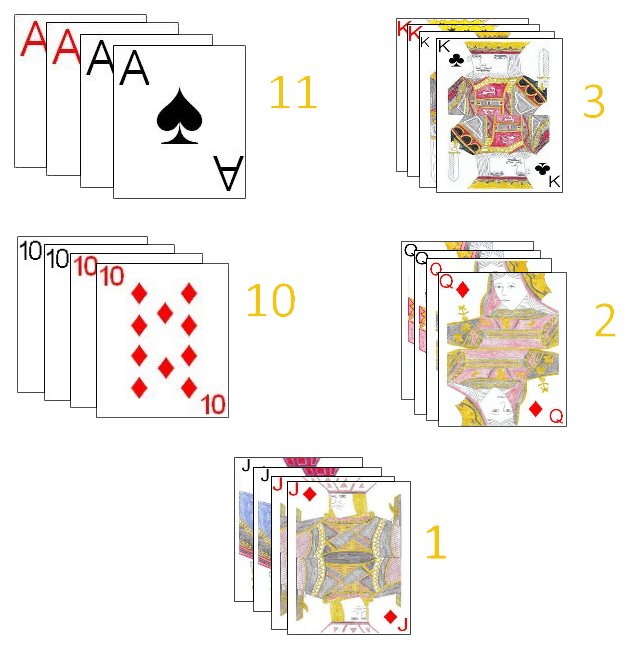
|
|
| Card | Card Point Value |
|---|
| Ace | 11 Each |
| Ten | 10 Each |
| King | 3 Each |
| Queen | 2 Each |
| Jack | 1 Each |
|
Selection of seating positions and first dealer can be performed in a variety of ways with cutting for low card common. Once this has been determined, the dealer can then begin the deal. Before the game begins, each player is provided with three special tokens (called lives). He places these tokens on the table in front of himself. The dealer begins distributing the cards one at a time, face-down in a clockwise direction. He continues dealing as far as the deck can be dealt evenly. Any extra cards should be placed face-down to the side, out of play.
The player to the dealer's immediate left leads any card of his choice from his hand to begin the first trick. Each other player in a clockwise direction then plays one card to this same trick. If a player has one or more cards of the same suit first led to this trick he must play it. If he does not have such a card he may play any card to the trick. The highest card of the suit originally led to the suit wins the trick, placing the won cards at his side in a pile. The first time any player is unable to play a card of the suit led to a trick he must immediately announce this when playing his card (of any other suit) to the trick. The top card of the remaining stock is revealed, setting the trump suit for this and all subsequent tricks during the current hand. After being exposed, and after all players have the opportunity to note the suit of this card, the card is turned face-down. Thus, the player must memorize the suit of this card to ensure they do not play a card of this suit, potentially winning unintended cards.
Each trick is won by the highest card of the trump suit played to the trick (if the trump suit has been exposed and if it contains any cards of this suit). If no trump suit has yet been exposed or no cards of the trump suit are found in the trick, the trick is won by the highest card of the suit first played to the trick. The winner of each trick leads the first card to the next trick.
Before play to the first trick, a play may ask for a one card trade with any other willing player. He does this by declaring this, depending on the denomination of the card he wants to trade. If he wants to trade a face card (King, Queen, or Jack) for another face card he states "A coat for a coat". If he wants to trade an Ace or Ten, he declares "A card for a card". The first opponent, if any, who accepts the trade is entitled to trade with the player. Both cards must be of the same type (A face card for a face card, or a card of denomination of Ace or 10 for another card which is an Ace or 10) and should be of the same suit. If the players find the cards traded are of the same suit, they must return the traded cards, unable to make the trade with that player for that type.
Each time a player wins a trick he must add to his own running score a number of points equal to the number of card points found in the trick. If his score reaches or exceeds 31 total card points, he must announce this, and, at the end of the hand loses one of his tokens. If no player has reached or exceed this total at the end of the hand, the player with the most current points loses a token instead. If a player loses the last of his tokens he must drop from the game. A player resets his current count total at the start of each new hand.
The game continues until there is just one active player remaining, who is declared the winner.
Complex Hearts:
Complex Hearts gets it's name not because the game itself is necessarily a difficult or complex game to play but rather that the scoring involves complex numbers from mathematics. The game was designed by mathematician and designer of several very popular Collectible Card Games, Richard Garfield.
The game itself is very similar to the game Omnibus Hearts, with the major difference being in the scoring after each hand. As mentioned, scoring includes the use of complex numbers in mathematics. The following shows the scoring for each card a player wins in tricks during each hand:
| Card | Scoring Value |
|---|
| Each Card in the Suit of Hearts | 1 + 0i |
| Queen of Spades | 0 + 13i |
| Jack of Diamonds | -10 + 0i |
| 10 of Clubs | Multiplies player's score for that hand by 0 + 2i |
Complex Numbers: For those who may be unfamiliar with complex numbers, a short explanation might be in order to assist in scorekeeping for this game. A complex number is a mathematical structure or binomial which consists of two components a real (or decimal) number and an imaginary number (indicated by the unit symbol i). These imaginary numbers are special numbers which, if squared, give a negative result of the squaring (such as the square root of -1). A complex number is written in the format a + bi, in which "a" is the real number component of the complex number and "b" is the imaginary component.
Since in this game we will need to do some arithmetic consisting of adding, subtracting and multiplying these special numbers, it might be helpful to briefly review these operations on complex numbers.
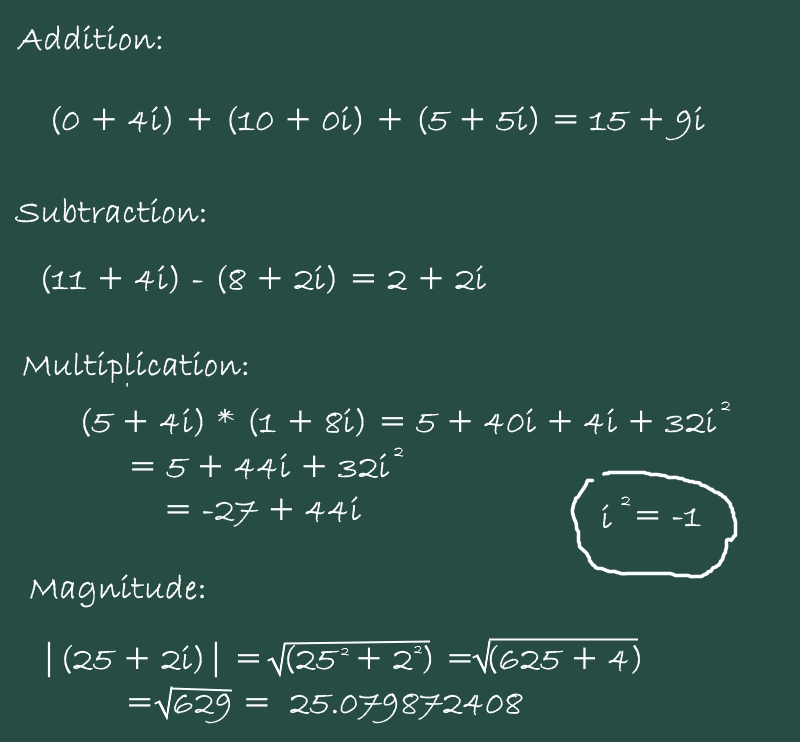
Addition and subtraction of complex numbers is similar to adding any polynomial, in which the "like terms" are added (or subtracted) to each other. Thus, all the real numbers in the equation would be added together and all the imaginary (i) portion of the terms would be added together. For example, (0 + 4i) + (10 + 0i) + (5 + 5i) would equate to (15 +
9i). Or, (11 + 4i) - (8 + 2i) would equate to (2 + 2i).
Multiplication of these complex numbers is also similar to normal multiplication of binomial terms. Thus, each portion of the first term in the complex number would be multiplied by each term in the second complex number. This is usually done using the FOIL method, which indicates multiplying the First terms together, then the Outer Terms together, next the Inner terms together, and lastly the Last terms together. As an example, (5 + 4i) * (1 + 8i) would equal 5 + 40i + 4i + 32i² which equals 5 + 44i + 32i². Because i² is equal to -1, this can then be simplified further to 5 + 44i - 32, which finally becomes (-27 + 44i).
These complex numbers are also sometimes referenced as to their magnitude (which is important in this game). The magnitude of a complex number is the absolute value of a complex number (a + bi),
which can thus be determined by calculating the square root of the squares of the real number and the imaginary number added together, or √(a² + b²). As an example, the magnitude of (25 + 2i) = √(25²
+ 2²) = √(625 + 4) = √(629) = 25.079872408.
Thus, a player, at the end of the hand would, using addition of these complex numbers, add (or subtract) from his current ongoing score all the points captured in tricks during that hand. If the player captures the 10 of clubs, the player would first need to calculate his total score for that hand on all other cards captured (if any) during that hand, and multiplying this result by (0 + 2i). This adjusted value would then be added to that players current ongoing accumulated score.
A player may also attempt to shoot the moon, as in most other forms of Hearts. In order to successfully shoot the moon, the player must capture every card in the suit of hearts as well as the Queen of spades. Any other cards are optional. If a player does manage to successfully shoot the moon, they have the option to either subtract a total 13 + 13i from their score, or add that amount to every other players score. Note that it is not necessary to also capture the Jack of diamonds and the 10 of clubs. However, is one or both of these cards are captured, the modified total (from the capture of one or both of these
additional cards) would either be the amount subtracted from your score or added to the other players.
The game continues from hand to hand, until, at the end of any hand, the magnitude of one or more player's scores reaches or exceeds 100. When this occurs, the game immediately with that player declared the loser of the game and the player with the lowest such magnitude is declared the game winner.
In addition to these differences regarding the scoring, there are a few other differences in Complex Hearts as well:
- As in standard Hearts, a player may not lead a card in the suit of Hearts until either a Heart or the Queen of Spades has already been played to any previous trick (unless the player has no other card in which he can lead to a trick)
- The player with the 2 of clubs leads the first card to the first trick. A player may not play the 10 of clubs to the first trick unless they have no other cards in the suit of clubs in the hand.
In all other aspects, this version of the game is played identically to the standard game.
Hartenjagen:
Hartenjagen is a game similar to Hearts which is popular in the Netherlands. Hartenjagen is also sometimes the name given in the Netherlands to the standard game of Hearts, using the rules at the top of the page.
Due to it's nation of origin, the game is often played under the name
Dutch Hearts. Although usually considered a variant of the game
Hearts, it also has resemblances to some of the Compendium style games.
Hartenjagen is designed for play by four players all playing independently and uses one standard 52 card deck (although a version for three players will also
be described, later). The ranking of the cards in this deck are as follows (from highest to lowest): Ace, King, Queen, Jack, 10, 9, 8, 7, 6, 5, 4, 3, 2.
The game is played over the course of two phases. During the first phase of the game (which will last for multiple hands), the players, as in standard Hearts, will attempt to win as few point scoring cards as possible, and thus have the lowest score. This first phase of the game is played identically to the standard game Hearts with the following differences:
- There is no card passing in Hartenjagen, thus each player will keep the cards as originally dealt for that hand.
- The player with the two of clubs leads the first card to the first trick.
- Players may lead a heart or spade to a trick during their lead, and are not required to wait until a heart or spade has been played to a previous trick.
- After each hand has completed, the players review the cards they have won in tricks during the hand and add this total to an ongoing, accumulated total for the game. The following are the point values for cards during the hand:
| Card | Point Value |
|---|
| Each Card in the Suit of Hearts | 1 Point Each |
| Jack of Clubs | 2 |
| Queen of Spades | 5 |
|
|
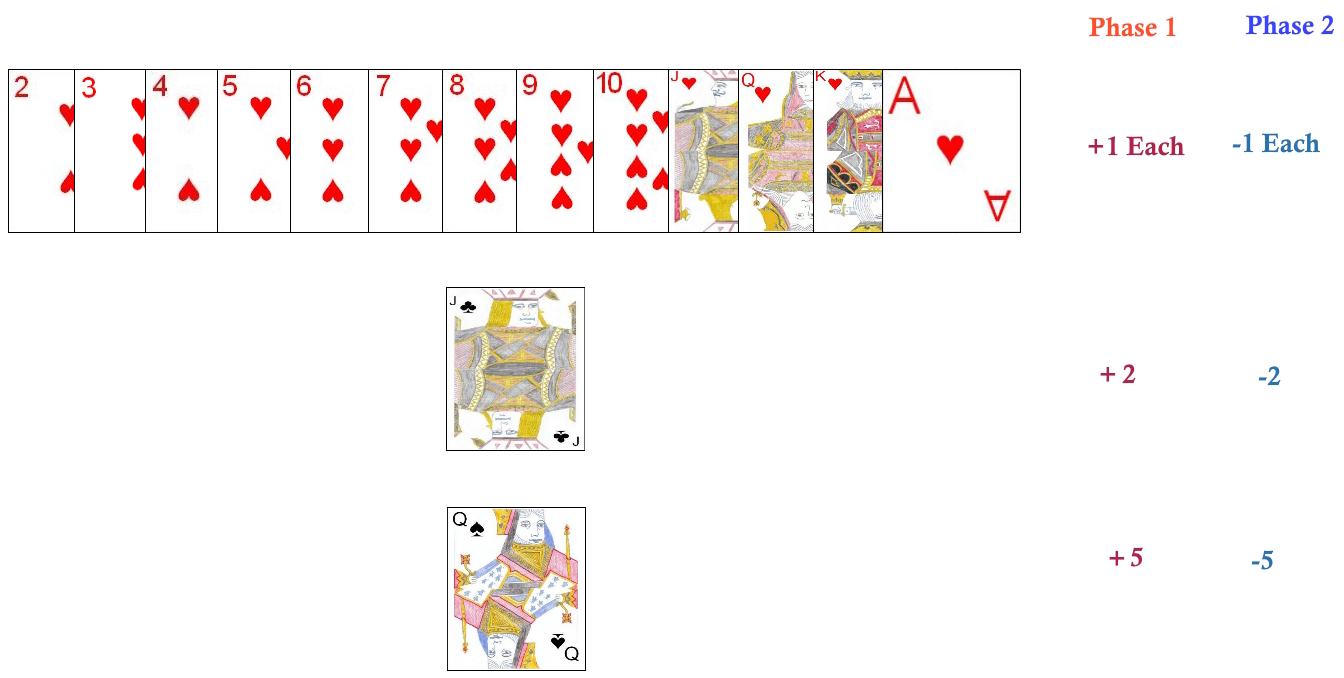
|
All other cards have a point value of 0.
- In order to successfully shoot the moon a player must manage to capture
every point during that hand. If a player manages to successfully shoot the
moon during this phase they add 0 points to their score but are entitled to
force each other player to add 20 points to their score.
Play continues until any player, at the end of a hand in this first phase, reaches or exceeds a total of 100 points. At this juncture, the game then switches to phase 2. This game is played very similarly to phase 1, with the same rules. However, during this phase, players attempt to capture (rather than avoid this capture) cards in the suit of hearts, the Jack of clubs and the Queen of spades, as, during this phase, players are entitled to subtract from their current ongoing score, a number of points based on the value of each of these cards. These cards have a point value equal to that in the first phase (as per the chart above), however, during this phase, these points are subtracted from their score rather than added. During this phase if a player manages to shoot the moon (earn every point in play that hand), that player is entitled to subtract 20 points from their score (no changes to the other player's scores).
The game continues during this second phase until one or more players, at the end of a hand, manages to reduce their score to 0 or less. The player with the lowest score is then declared the winner. If two or more players have a score at 0 or less, and that score is tied,
additional hands must be played until there is one clear winner, a player with the lowest score, and which is below 0.
Three Player Hartenjagen:
As mentioned previously for this game, a three person version of this game is also sometimes played. The game is played similarly to the standard game with the following differences:
- The game is played using a reduced deck consisting of exactly 36 cards.
The form this shortened deck, all cards of rank five and lower are removed.
- The player with the six of clubs leads the first card to the first trick.
- Phase one continues until one or more players, at the end of any hand has accumulated a total score of 80 points or more. After this phase two immediately begins. As in the standard Hartenjagen, the first player to reduce his score to zero or less during phase two is declared the game winner.
Other than these differences, the three player variant of Hartenjagen is played identically to the four player variant.
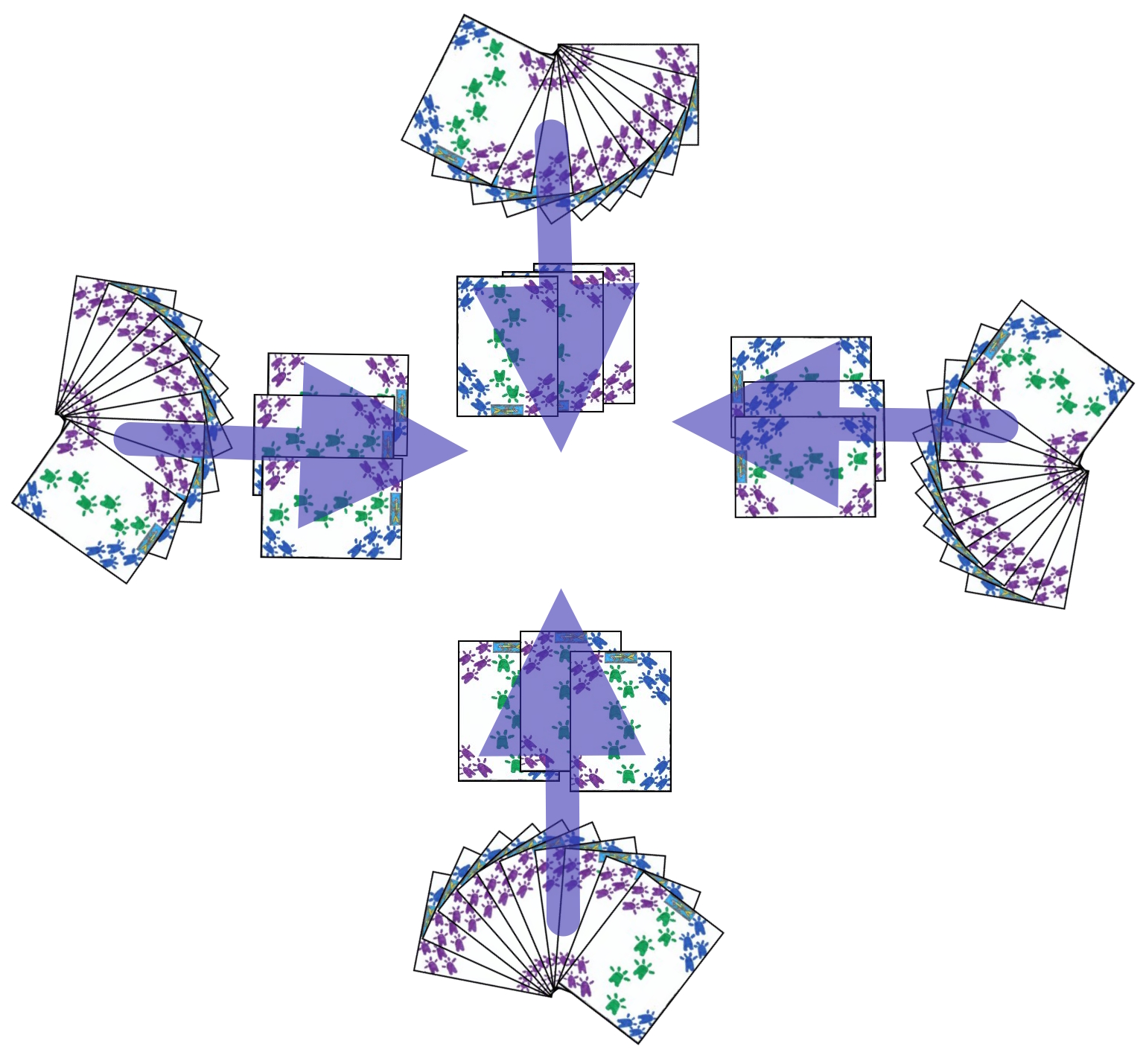 Dirty Nasty Filthy Hearts
Dirty Nasty Filthy Hearts:
Dirty Nasty Filthy Hearts is a variant of Hearts which is played in the southern states in the US. It is played identically to Black Lady with the following additional differences:
- The game is designed specifically for four players.
- As in most other forms of Hearts, three cards are passed before start of
play on each hand. However, the designated dealer for that hand decides how these cards will be passed on this hand. This can be any combination of passing, such as three to the left, three cards across,
three cards to the right, 2 cards passed to the right and one to the left, one card to the left one to the right and one across, or any other combination of such passing). However, this game also features one additional passing option which a dealer can select, a pass to the center. Using this passing option, each player discards three cards, face-down from their hand, to the center of the table. The dealer then shuffles all 12 cards found in the center of the table and then deals out, face-down, three cards to each player.
- The player having the two of clubs plays the first card to the first trick.
- Winning the Queen of Spades earns winner of the card 26 points. Each other Queen won in tricks (including the Queen of hearts) earns a player 13 points. Each heart won in a trick wins that player 1 point.
- Winning the Jack of diamonds (called the "lil man") in a trick allows the player winning it to subtract 10 points from his current score.
- No point scoring cards (either positive or negative) can be played on the first trick
of each hand. Hearts may not be led to any trick until a player has played a card in the Hearts suit to a trick in which another suit was initially led.
- Once any player reaches or exceeds 300 points at the end of a hand, the game ends and the player with the lowest total score is declared the game winner.
- If a player manages to shoot the moon, they immediately win the entire game. Shooting the moon in this game requires capturing all the hearts as well as all the Queens.
Other than these differences, this variant is played identically to Black Lady, as described higher in this page.
Copyright © 2015 CatsAtCards.com. All rights reserved.
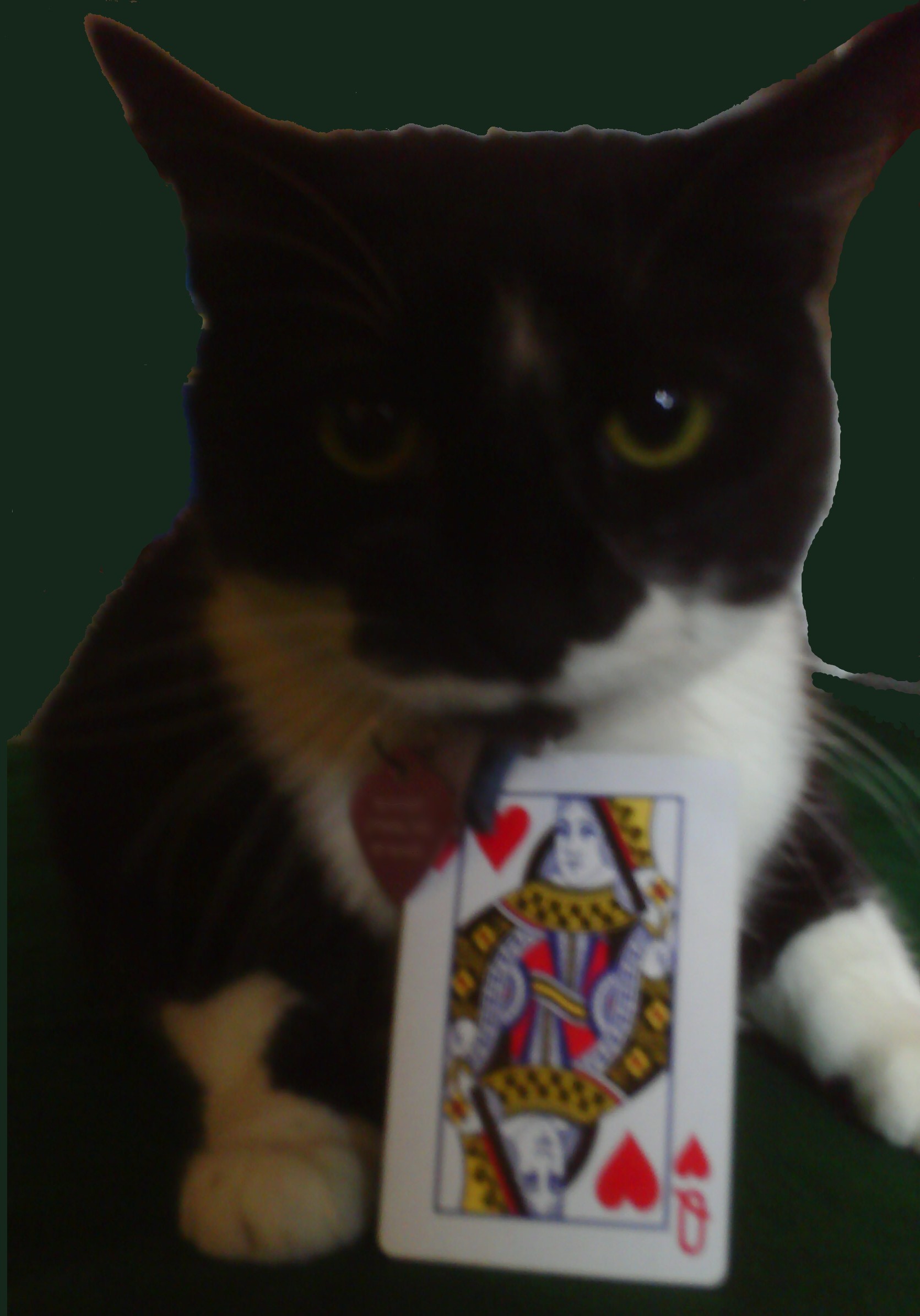 Hearts is a trick taking game with an interesting twist. When playing Hearts, the object is to avoid taking specific cards which is quite different than the usual goal of winning as many tricks as possible with most trick taking games.
Hearts is a trick taking game with an interesting twist. When playing Hearts, the object is to avoid taking specific cards which is quite different than the usual goal of winning as many tricks as possible with most trick taking games.
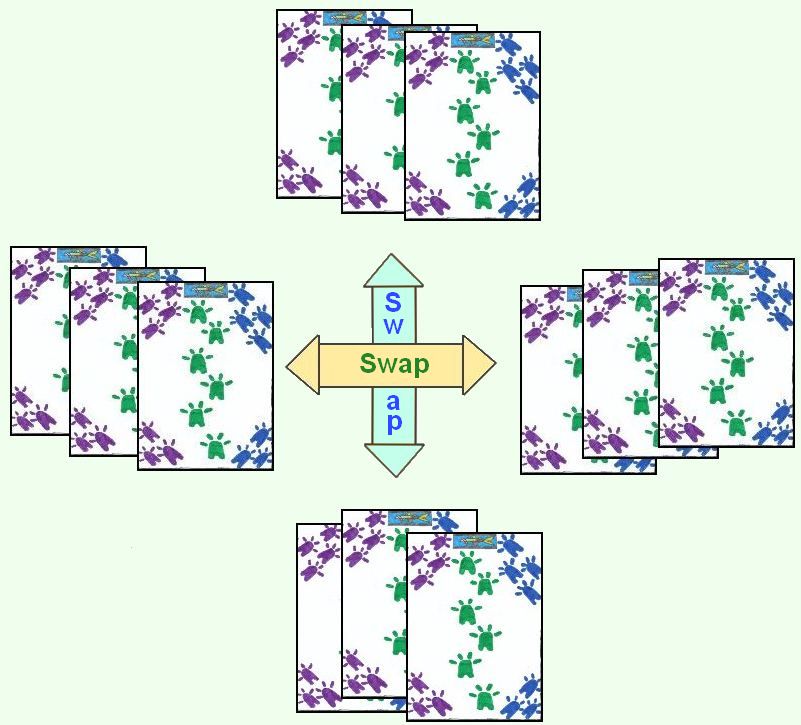

 In this often played version of Hearts, the Queen of Spades is played as an additional penalty card when won in a trick. The player, who at the end of the hand finds the Queen of Spades in their won tricks scores 13 penalty points. In this version the player to lead to the first trick may not lead spades or hearts (unless he has only spades and/or hearts in his hand) to the first trick. In order to shoot the moon in this version, the player must win all the hearts AND the Queen of Spades (which allows the player to subtract 26 points from their score or add 26 penalty points to each opponents score). In all other aspects Black Lady is played identically to standard Hearts as described above.
In this often played version of Hearts, the Queen of Spades is played as an additional penalty card when won in a trick. The player, who at the end of the hand finds the Queen of Spades in their won tricks scores 13 penalty points. In this version the player to lead to the first trick may not lead spades or hearts (unless he has only spades and/or hearts in his hand) to the first trick. In order to shoot the moon in this version, the player must win all the hearts AND the Queen of Spades (which allows the player to subtract 26 points from their score or add 26 penalty points to each opponents score). In all other aspects Black Lady is played identically to standard Hearts as described above.

 After the deal, each player then examines his hand and one round of bidding follows. This bidding begins with the player to the immediate left of the dealer and commences in a clockwise rotation. Each player has one opportunity to bid some number of chips in exchange for the privilege of naming the penalty suit for the hand. When bidding a player only names a number but does not name the suit he will name if he is the high bidder.
Each successive bidder must either pass or bid a higher bid than that of any other player. Obviously, a player may never bid a number of chips higher than the number of chips he has. After each player has had one opportunity to make a bid, the high bidder then places the number of chips he bid in the center of the table and names the suit which will be the penalty suit. The high bidder also makes the opening lead to the first trick. If all players pass, the cards are shuffled together and the deal passes to the next player in turn.
After the deal, each player then examines his hand and one round of bidding follows. This bidding begins with the player to the immediate left of the dealer and commences in a clockwise rotation. Each player has one opportunity to bid some number of chips in exchange for the privilege of naming the penalty suit for the hand. When bidding a player only names a number but does not name the suit he will name if he is the high bidder.
Each successive bidder must either pass or bid a higher bid than that of any other player. Obviously, a player may never bid a number of chips higher than the number of chips he has. After each player has had one opportunity to make a bid, the high bidder then places the number of chips he bid in the center of the table and names the suit which will be the penalty suit. The high bidder also makes the opening lead to the first trick. If all players pass, the cards are shuffled together and the deal passes to the next player in turn.
 This is another game which uses the Hearts concept of trying avoid certain penalty cards during play. Also commonly known as Four Jacks, Four Knaves and Quatre Valets, this game uses a stripped down deck with the number of cards depending on the number of players in the game. The most commonly played version of Polignac is for four players using a 32 card deck which consists of one card in each suit in the following denominations (from high to low); Ace, King, Queen, Jack, 10, 9, 8, 7. Shuffling, determining the first dealer and seating positions is done identically to the standard game of Hearts. After the shuffle and cut, the dealer distributes the cards in a clockwise rotation one card at a time until each player has 8 cards. The player to the immediate left of the dealer leads any card of his choice to the first trick.
This is another game which uses the Hearts concept of trying avoid certain penalty cards during play. Also commonly known as Four Jacks, Four Knaves and Quatre Valets, this game uses a stripped down deck with the number of cards depending on the number of players in the game. The most commonly played version of Polignac is for four players using a 32 card deck which consists of one card in each suit in the following denominations (from high to low); Ace, King, Queen, Jack, 10, 9, 8, 7. Shuffling, determining the first dealer and seating positions is done identically to the standard game of Hearts. After the shuffle and cut, the dealer distributes the cards in a clockwise rotation one card at a time until each player has 8 cards. The player to the immediate left of the dealer leads any card of his choice to the first trick.



 Addition and subtraction of complex numbers is similar to adding any polynomial, in which the "like terms" are added (or subtracted) to each other. Thus, all the real numbers in the equation would be added together and all the imaginary (i) portion of the terms would be added together. For example, (0 + 4i) + (10 + 0i) + (5 + 5i) would equate to (15 +
9i). Or, (11 + 4i) - (8 + 2i) would equate to (2 + 2i).
Addition and subtraction of complex numbers is similar to adding any polynomial, in which the "like terms" are added (or subtracted) to each other. Thus, all the real numbers in the equation would be added together and all the imaginary (i) portion of the terms would be added together. For example, (0 + 4i) + (10 + 0i) + (5 + 5i) would equate to (15 +
9i). Or, (11 + 4i) - (8 + 2i) would equate to (2 + 2i).

